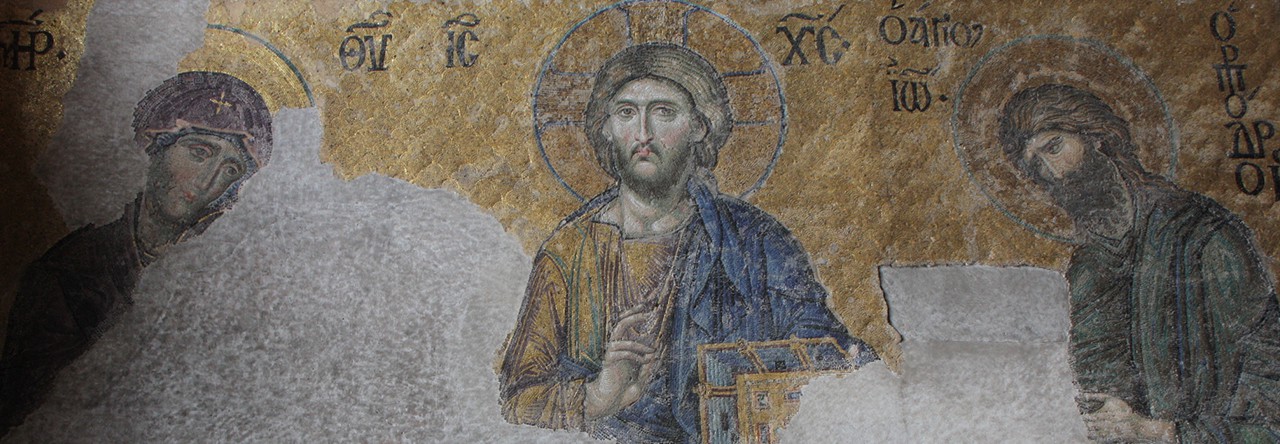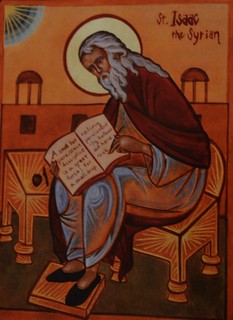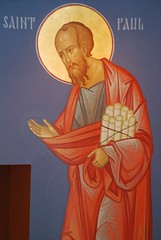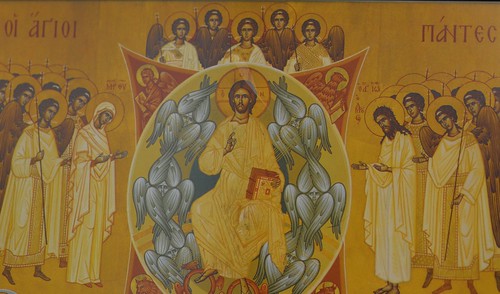 St. Basil the Great wrote an extensive commentary on the six days of creation as found in Genesis 1-2 (Basil read both chapters together as one story). His commentary is called the Hexaemeron. Though it contains comments about the creation of humans, Basil’s brother, St. Gregory of Nyssa, was concerned that Basil had not written enough about the creation of human beings and so Gregory composed an addendum known as ON THE MAKING OF MAN. His goal was to complete the picture which he felt Basil hadn’t done and also to answer some of Basil’s critics as well as some of the questions raised by heretics about Basil’s commentary on the creation of the world.
St. Basil the Great wrote an extensive commentary on the six days of creation as found in Genesis 1-2 (Basil read both chapters together as one story). His commentary is called the Hexaemeron. Though it contains comments about the creation of humans, Basil’s brother, St. Gregory of Nyssa, was concerned that Basil had not written enough about the creation of human beings and so Gregory composed an addendum known as ON THE MAKING OF MAN. His goal was to complete the picture which he felt Basil hadn’t done and also to answer some of Basil’s critics as well as some of the questions raised by heretics about Basil’s commentary on the creation of the world.
 Reading through St. Gregory’s work on the creation of humans caused me to think about how we today might describe what it is to be human. Orthodox theology says Jesus Christ is fully human. Modern science has defined a human in terms of our genetic structure – a science which no one in the 4th Century even remotely imagined. So it raises questions for us today – if we say Christ is fully human, do we mean that Christ has a fully human genetic makeup – 23 chromosomes and all the biological and genetic markers of every human being? If so, then we might find ourselves having to rethink some of the concerns of the Christian theologians of the Patristic era. For they certainly were not thinking genetics when they wrote about what it is to be human or what it means that Jesus, God incarnate is fully and perfectly human.
Reading through St. Gregory’s work on the creation of humans caused me to think about how we today might describe what it is to be human. Orthodox theology says Jesus Christ is fully human. Modern science has defined a human in terms of our genetic structure – a science which no one in the 4th Century even remotely imagined. So it raises questions for us today – if we say Christ is fully human, do we mean that Christ has a fully human genetic makeup – 23 chromosomes and all the biological and genetic markers of every human being? If so, then we might find ourselves having to rethink some of the concerns of the Christian theologians of the Patristic era. For they certainly were not thinking genetics when they wrote about what it is to be human or what it means that Jesus, God incarnate is fully and perfectly human.
 The Patristic theologians were concerned with creating a synthesis between Scripture and Platonism (I am including neo-Platonism in this) as well as with ideas from the Stoics and Aristotle. That was the “science” of their day, and they did accept these philosophers as espousing scientific truth – truths that are not debatable. Several Patristic writers, Gregory of Nyssa among them, held to assumptions that sexual desire and gender were not part of God’s original creation of or plan for humans. These were provisional things which God used as a result of human rebellion against God’s plan. The Patristic writers worked very hard to create a synthesis in which they incorporated the prevalent ideas of the Greek philosophical “science” (which were regarded as non-negotiable truth) with the witness of Scripture. The ideas from philosophy were so much a part of the thinking of their day that they knew they had to reconcile the Scriptures to the truth assumptions of the great philosophers if they were ever to get Christianity a hearing among the educated people of their day. Many of the Patristic writers were well trained in the writings of the great philosophers, and even if they weren’t their society values were permeated by these teachings. It is not some artificial synthesis the Patristic writers were attempting to force, they were simply incorporating the background assumptions of their culture with the claims of Scripture. Truth is one, and so they believed they needed to discern how to hold science, philosophy and Scripture together.
The Patristic theologians were concerned with creating a synthesis between Scripture and Platonism (I am including neo-Platonism in this) as well as with ideas from the Stoics and Aristotle. That was the “science” of their day, and they did accept these philosophers as espousing scientific truth – truths that are not debatable. Several Patristic writers, Gregory of Nyssa among them, held to assumptions that sexual desire and gender were not part of God’s original creation of or plan for humans. These were provisional things which God used as a result of human rebellion against God’s plan. The Patristic writers worked very hard to create a synthesis in which they incorporated the prevalent ideas of the Greek philosophical “science” (which were regarded as non-negotiable truth) with the witness of Scripture. The ideas from philosophy were so much a part of the thinking of their day that they knew they had to reconcile the Scriptures to the truth assumptions of the great philosophers if they were ever to get Christianity a hearing among the educated people of their day. Many of the Patristic writers were well trained in the writings of the great philosophers, and even if they weren’t their society values were permeated by these teachings. It is not some artificial synthesis the Patristic writers were attempting to force, they were simply incorporating the background assumptions of their culture with the claims of Scripture. Truth is one, and so they believed they needed to discern how to hold science, philosophy and Scripture together.
So, for example St. Gregory writes:
“While two natures – the Divine and incorporeal nature, and the irrational life of brutes – are separated from each other as extremes, human nature is the mean between them: for in the compound nature of man we may behold a part of each of the natures I have mentioned – of the Divine, the rational and intelligent element, which does not admit the distinction of male and female; of the irrational, our bodily form and structure, divided into male and female . . . For he says first that God created man in the image of God (showing by these words, as the Apostle says, that in such a being there is no male or female): then he adds the peculiar attributes of human nature, male and female created He them (Gen 1:27).” (pp 78-79)
In St. Gregory’s reading, the first humans did not have gender – gender is added to the humans in the “second” creation of humans which occurs after the Fall of Adam and Eve. Some of his ideas about sex and gender were common to the Greek philosophers who were influential in his world. Gregory attempts to harmonize the ideals of this philosophy about how humans are “higher” than mere animals with what he read in Scripture.
Gregory finds support for this idea in his reading of Genesis 1:27, which in our English Bibles usually gets translated as :
So God created man in his own image, in the image of God he created him; male and female he created them.
St. Gregory, however adds punctuation to the text, making it into two clearly distinct acts. [His adding punctuation, by the way, is legitimate in the sense that the original texts lacked any punctuation – our English translations with their punctuation are no more correct than Gregory’s]. Gregory’s reading is like this:
So God created man in his own image, in the image of God He created him.
Male and female He created them.

Gregory treats these as two separate sentences, two separate acts of God. First God creates humans. Only later does God make them into male and female. In the first action, humans are created in God’s image – and since God has no gender, neither do humans in their God-created natural state. Gender becomes part of human existence only after the Fall when humans choose to be more like all the other animals. So for St. Gregory as for many Patristic writers, gender and sexual reproduction belong solely to the world of the Fall and are not a natural part of what it is to be human.
“… but as brute life first entered into the world, and man, for the reason already mentioned, took something of their nature (I mean the mode of generation) . . . (p 88)
Sexual reproduction (Gregory’s “the mode of generation“) becomes part of the human condition only after the Fall. If this is Orthodox anthropology, it raises interesting questions about what it is to be human and what it means to be fully human. This has implications for Christ Himself whether he is male, or as a “perfect” human is He genderless as Adam and Eve were thought to have been. Does Orthodox anthropology require that Christ have 23 chromosomes? If only that which is assumed is saved, does Christ take on our entire genetic nature, or is our genetic nature not part of what Christ unites to God?
St. Gregory continues:
These attributes, then human nature took to itself from the side of the brutes; for those qualities with which brute life was armed for self-preservation, when transferred to human life, became passions; for the carnivorous animals are preserved by their anger, and those which breed largely by their love of pleasure; cowardice preserves the weak, fear that which is easily taken by more powerful animals, and greediness those of great bulk; and to miss anything that tends to pleasure is for the brutes as matter of pain. All these and the like affections entered man’s composition by reason of the animal mode of generation.” (pp 88-89)
We can even see in the passage above that St. Gregory is really describing survival of the species – animals have traits good for self-preservation. Gregory accepts a certain anthropomorphic interpretation of animals – their behavior is seen as reflecting virtues and vices. Carnivores attack because they are angry, and animals engage in sex because they love pleasure. These “animal traits” became part of human behavior when humans fell from grace and came to live by animals senses and sexual reproduction. Pain became part of human experience once we chose to live for pleasure – this is how God punished us for rebelling against him.

Modern science more sees us as more projecting human emotions, virtues and vices on animals, rather than animals possessing such traits. Gregory sees us as receiving emotions, virtue and the desire for pleasure from the animal nature we took on in choosing to share the animal life. Whether we could in any way reconcile Patristic “science” with modern science is the challenge we face in the modern world. Scientific reasoning is as all pervasive today as was Platonism in the age of the Fathers. The ancient Christians assumed the need to reconcile these truths and created a synthesis that did just that. We have to consider whether we can do the same and thus follow the mind of the Fathers.
St. Gregory, like many of the Eastern Patristic writers, holds to ideas that seem similar to the notions of “original sin” in the West. Gregory sees our love of pleasure as stemming from the animal nature we now inherit. His writing rejects the Platonic ideas that Origin more readily accepted, but still we see in them a more Christianized version of a notion that our physical nature is not really part of what God intended for us. Humans indeed have animal traits and share an animal nature but that is really only the result of sin. Modern science on the contrary would say humans evolved from other animal forms over a long history, and any animal characteristics in us are because of our genetic relationship to other animals.
“Thus our love of pleasure took its beginning from our being made like to the irrational creation, and was increased by the transgressions of men, becoming the parent of so many varieties of sins arising from pleasure as we cannot find among the irrational animals. Thus the rising of anger in us is indeed akin to the impulse of brutes; but it grows by the alliance of thought: for thence come malignity, envy, deceit, conspiracy, hypocrisy; all these are the result of the evil husbandry of the mind; for if the passion were divested of the aid it receives from thought, the anger that is left behind is short-lived and not sustained, like a bubble, perishing straightway as soon as it come into being. Thus the greediness of swine introduces covetousness, and the high spirit of the horse becomes the origin of pride; and all the particular forms that proceed from the want of reason in brute nature become vice by the evil use of the mind.” (pp 89-90)

Gregory sees the animal nature (love of pleasure, vices, passions) as actually being made even worse by human free will and rationality. Swine are greedy but humans turn that into an art of covetousness. Carnivores are angry but humans add to this ill will, envy, deceit, conspiracy and hypocrisy. It is our human minds, the very thing God bestowed on us humans to distinguish us from all other animals, which change animal behaviors into sin. Animals act the way they do because of their nature, humans imitate their bad behavior by choice, according to Gregory.
St. Gregory’s acceptance of the “science” of his day raises many interesting questions. He does not reject the science of his day. He accepts it as factually true and thus Scripture also being true should easily reconcile with science. He is neither afraid of the pagan science nor does he see any need to assume that science and the Bible are presenting opposing ideas. Gregory works to create a synthesis of what he believes to be true, regardless of the source. If he held to these same principles today, it would suggest that Gregory might have been willing to work to create a synthesis between modern science and the Bible. Truth is truth for him, and it is we who have to work to reconcile truths if they appear to be in opposition to each other.

St. Gregory of Nyssa is not alone in his thinking on these issues among Patristic writers. We can see many of the same assumptions about sexual reproduction and gender in St. Maximos the Confessor who writes more than 200 years after Gregory. The great theological synthesis they were creating incorporated the science of their day, a science they saw no need to refute.
Next: Reflecting on St. Gregory of Nyssa’s The Making of Man (II)


 “Where am I to get meat to give to all this people? For they weep before me and say, ‘Give us meat, that we may eat.’ I am not able to carry all this people alone, the burden is too heavy for me.” … And the LORD said to Moses, “… say to the people, ‘Consecrate yourselves for tomorrow, and you shall eat meat; for you have wept in the hearing of the LORD, saying, “Who will give us meat to eat? For it was well with us in Egypt.” Therefore the LORD will give you meat, and you shall eat. You shall not eat one day, or two days, or five days, or ten days, or twenty days, but a whole month… But Moses said, “The people among whom I am number six hundred thousand on foot; and thou hast said, ‘I will give them meat, that they may eat a whole month!’ Shall flocks and herds be slaughtered for them, to suffice them? Or shall all the fish of the sea be gathered together for them, to suffice them?” And the LORD said to Moses, “Is the LORD’s hand shortened? Now you shall see whether my word will come true for you or not.”
“Where am I to get meat to give to all this people? For they weep before me and say, ‘Give us meat, that we may eat.’ I am not able to carry all this people alone, the burden is too heavy for me.” … And the LORD said to Moses, “… say to the people, ‘Consecrate yourselves for tomorrow, and you shall eat meat; for you have wept in the hearing of the LORD, saying, “Who will give us meat to eat? For it was well with us in Egypt.” Therefore the LORD will give you meat, and you shall eat. You shall not eat one day, or two days, or five days, or ten days, or twenty days, but a whole month… But Moses said, “The people among whom I am number six hundred thousand on foot; and thou hast said, ‘I will give them meat, that they may eat a whole month!’ Shall flocks and herds be slaughtered for them, to suffice them? Or shall all the fish of the sea be gathered together for them, to suffice them?” And the LORD said to Moses, “Is the LORD’s hand shortened? Now you shall see whether my word will come true for you or not.”












 I occasionally read science texts though I’m not a scientist. I appreciate the sense of discovering truth through science, and the recognition by science that the truth it proclaims today may be only an approximation of the universe as it really is. Future discoveries can show that what science at one time believed (even dogmatically!) to be true, can at a later date be shown to be incomplete or completely wrong. So as I just finished reading a couple of books about the nature of time (Carlo Rovelli:
I occasionally read science texts though I’m not a scientist. I appreciate the sense of discovering truth through science, and the recognition by science that the truth it proclaims today may be only an approximation of the universe as it really is. Future discoveries can show that what science at one time believed (even dogmatically!) to be true, can at a later date be shown to be incomplete or completely wrong. So as I just finished reading a couple of books about the nature of time (Carlo Rovelli: 



























